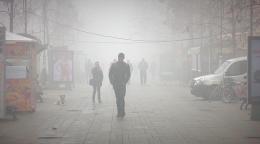Lockdowns around the world have had a huge and rapid effect on nitrogen oxide emissions and worldwide ozone pollution, new research has shown.
Ozone pollution forms when sunlight reacts with nitrogen oxides released from cars and industry, and is not to be confused with the ozone layer, a layer in the stratosphere that absorbs ultraviolet radiation from the sun.
At surface level, ozone pollution damages vulnerable people’s lungs, and is thought to have caused 365,000 deaths in 2019.
It also damages the ability of plants to photosynthesise, reducing their growth.
In the early part of the coronavirus pandemic, emissions of nitrogen oxides (NOx) decreased by 15% globally, with some areas seeing drops of up to 50%, according to NASA’s Jet Propulsion Laboratory (JPL) in Southern California.
Watch: The murky issue of air pollution in North Macedonia
Read more: A 1988 warning about climate change was mostly right
By June 2020, ozone levels had dropped to a level that experts thought would take at least 15 years to reach by conventional means, such as regulations.
Researchers led by JPL scientist Kazuyuki Miyazaki used this opportunity to research the two main oxides of nitrogen: nitrogen oxide and nitrogen dioxide, and the effects of local measures.
The more stringent the lockdown a nation imposed, the greater the reduction in emissions. For example, China’s stay-at-home orders in early February 2020 produced a 50% drop in NOx emissions in some cities within a few weeks.
Most US states achieved a 25% drop later in the spring.
The total result of the reduced NOx emissions was a 2% drop in global ozone.
Read more: Why economists worry that reversing climate change is hopeless
This is equal to half the amount that the most aggressive NOx emission controls considered by the Intergovernmental Panel on Climate Change were expected to produce over a 30-year period.
JPL scientist Jessica Neu said: “I was really surprised at how large the impact on global ozone was. We expected more of a local response at the surface.”
The researchers used measurements of NOx, ozone and other atmospheric gases from five NASA and European Space Agency satellites that observe Earth.
Read more: Melting snow in Himalayas drives growth of green sea slime visible from space
These findings indicate that both NOx emissions and global ozone will climb again as the world economy revs back up.
JPL scientist Kazuyuki Miyazaki said: “I was very happy that our analysis system was able to capture the detailed changes in emissions across the world.
“The challenging and unprecedented nature of this work is a testament to improvements in satellite monitoring in service of societal needs.”














